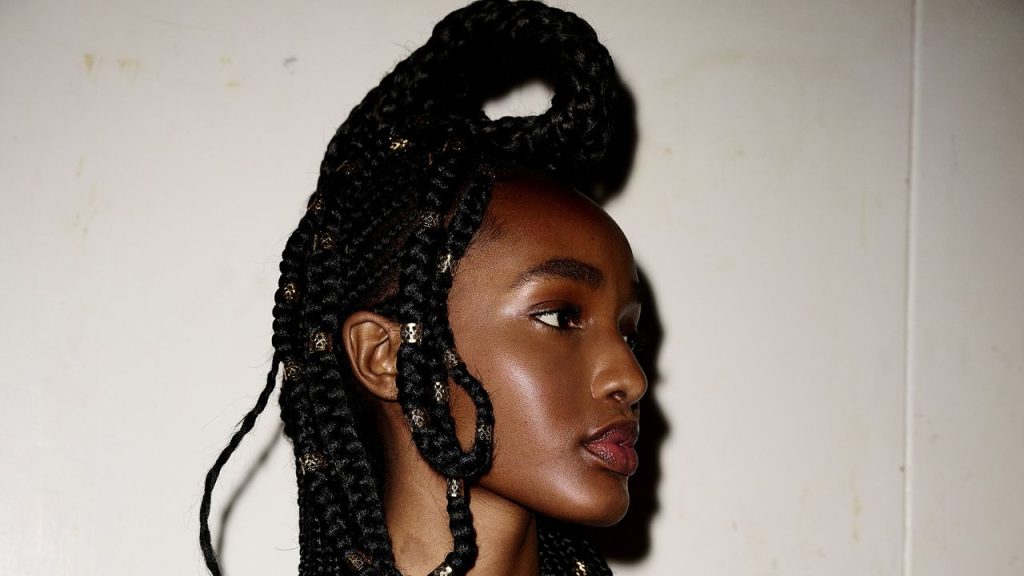Foday Dumbuya’s autumn/winter 2025 presentation unfolded as a heartfelt tribute to the rise of grime music, showcasing not only the vibrant beats and narratives of the genre but also celebrating Afro-textured hair as an integral aspect of identity and culture. Speaking passionately at the historic Abbey Road Studios during London Fashion Week, Dumbuya emphasized the importance of amplifying African narratives, asserting that African history is indeed global history. The designer beautifully fused British and West African tailoring, resulting in a collection marked by muted sandy hues and loose denim adorned with artistic sunshine motifs. The show was further elevated by performances from esteemed grime artists like Akala, Wretch 32, Ghetts, and D Double E, whose contributions have significantly shaped the genre and its cultural impact.
One of the standout features of the event was the innovative hairstyling that drew inspiration from traditional African styles. The models sported Bantu knots, cleverly transformed into pillars of wavy and coily synthetic hair, creating a look that was both striking and elegant. Freeform locs adorned with dangling beads added a playful touch, while a modern interpretation of cornrows showcased geometric patterns that spilled into braided cylinders. Nick Irwin, the hairstylist behind these creative looks, described the concept behind the styles as allowing for stronger silhouettes typically seen in autumn/winter collections. This juxtaposition of heavy clothing with intricate hairstyles played with the idea of negative space, highlighting the profound connection between fashion and cultural narratives.
Irwin shared insights about the inspirations behind the hairstyles, which spanned a diverse range of African cultures while also embracing late ’90s and early 2000s aesthetics. Influenced by iconic figures like Lauryn Hill, he introduced hair cuffs and slightly undone braids to give the looks a contemporary feel. His intention was to maintain a sense of realism and authenticity, grounding the styles in a way that resonated with the audience without veering too far into avant-garde territory. Irwin beautifully articulated the mission of Labrum—storytelling through fashion—emphasizing the importance of representation and the interconnectedness of individual narratives within the larger cultural tapestry.
Complementing the impactful hair, the makeup designed by Jessica DeBruyne used products from Refy and S’able Labs with a focus on enhancing each model’s natural beauty, particularly celebrating melanin-rich skin. DeBruyne expressed her aim to create an authentic look that seamlessly aligned with Labrum’s vision of bridging African cultural elements with contemporary Western fashion. This resulted in a cohesive presentation that not only looked beautiful but also told a story, enriching the overall narrative of the collection. The makeup was tailored to accentuate individuality while honoring the unique characteristics of each model, a vision that resonated deeply with the audience.
The entire experience at Abbey Road Studios transcended mere fashion presentation—it was a gathering that honored culture, history, and the powerful impact of community. Each element of the show, from the garments to the hairstyles and makeup, came together to reflect a shared journey marked by resilience and creativity. Grime music, with its roots in the British urban landscape, served as the perfect backdrop, symbolizing a movement that continues to evolve while remaining fiercely authentic to its origins. The synergy between the music and fashion highlighted how both art forms could exist harmoniously, drawing from personal and collective stories that define identities.
As the audience absorbed the atmosphere, it became evident that Dumbuya’s presentation was more than just a seasonal showcase; it was a powerful acknowledgment of the stories that shape us. By embracing the vibrancy of Afro-textured hair and weaving it into the fabric of contemporary fashion, Labrum is not just creating clothes but is actively participating in a broader dialogue about culture, heritage, and representation. The legacy of African and Caribbean narratives is alive and well in modern-day creative spaces, and through initiatives like this, we see how they can inspire future generations to embrace their roots and express themselves boldly. The celebration of these narratives in mainstream fashion shows a promising shift toward inclusivity, where every voice and story matters.

